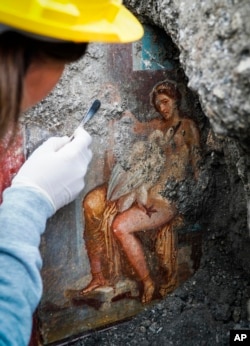This is What’s Trending…
Scientists have uncovered a sensual drawing on a wall in the ruins of ancient Pompeii.
The fresco represents the myth of Leda and the Swan. In the story, the Roman god Jupiter, takes the form of the bird, the swan. It has sex with the mortal girl Leda, who becomes pregnant.
The painting shows a naked Leda seated with the Swan on top of her.
Leda and the Swan was a common subject of artwork in the ancient Roman towns of Pompeii and Herculaneum. Both were destroyed by the volcanic burst of Mount Vesuvius in the year 79.
Famous artists have drawn representations of Leda and the Swan throughout history, including Leonardo da Vinci and Michelangelo. Irish poet W.B. Yeats wrote a poem about the story, as well.
Experts say this recently discovered image of Leda and the Swan is special.
Massimo Osanna is the director of the Pompeii archaeological park. He praised the fresco as exceptional because Leda appears to be looking out from the picture. Osanna told the Italian news agency ANSA, “Leda watches the spectator with a sensuality that’s absolutely pronounced.”
The fresco was found inside a costly domus, or home, which stood near the center of town. Archaeologists discovered the still-colorful work of art last week during a dig aimed at protecting the ancient city’s structures. Heavy rainfall and usual wear-and-tear have caused some ruins to collapse.
Ossana said the home’s owner may have been a rich trader. The owner may have wanted to make people believe he was cultured with his choice of myth-related frescoes.
Because of safety concerns, the still-undug parts of the home where the fresco was found will likely remain that way, ANSA reported. Archaeologists are still considering removing the fresco, as well as another fresco discovered in the home earlier this year, to a place where “they can be protected and shown to the public,” Osanna said.
The Pompeii archaeological park is one of Italy’s top tourist sites. About 2.5 million people visit each year.
And that’s What’s Trending Today…
I'm Ashley Thompson.
The Associated Press reported this story. Ashley Thompson adapted it for Learning English with additional sources. Caty Weaver was the editor.
________________________________________________________________
Words in This Story
fresco - n. a painting that is done on wet plaster
myth - n. an idea or story that is believed by many people but that is not true
archaeological - adj. related to archaeology, the science that deals with past human life and activities by studying the bones, tools, etc., of ancient people
spectator - n. a person who watches an event, show, game, activity, etc., often as part of an audience
absolutely - adv. in an absolute way: completely or totally
tourist - n. a person who travels to a place for pleasure








